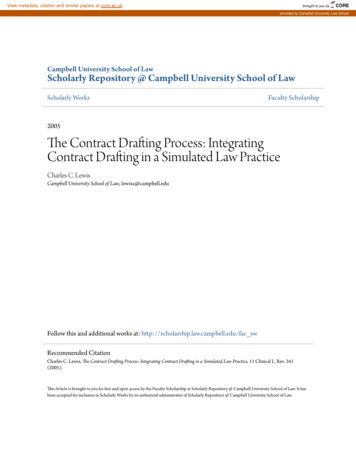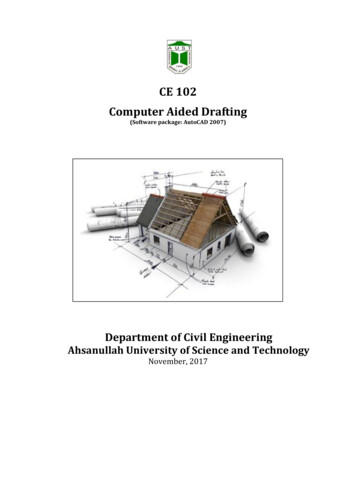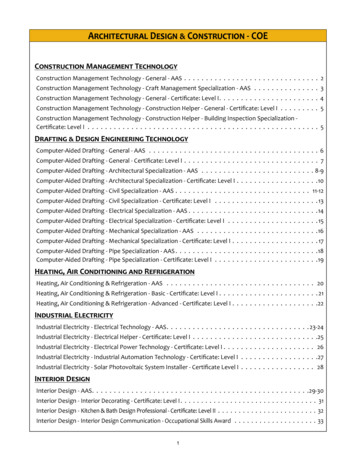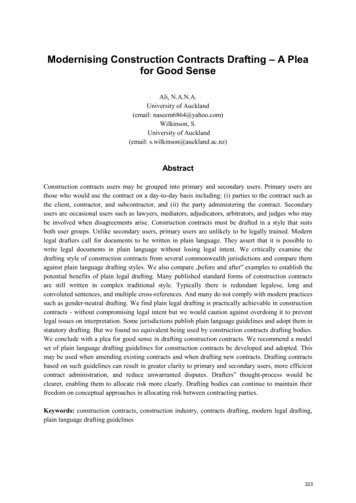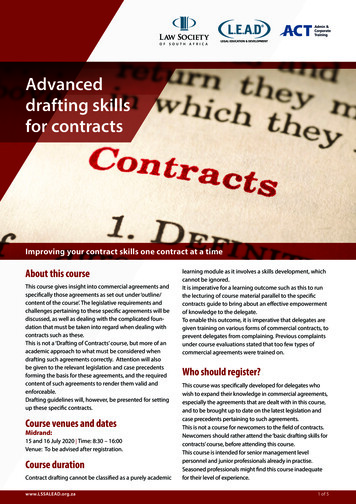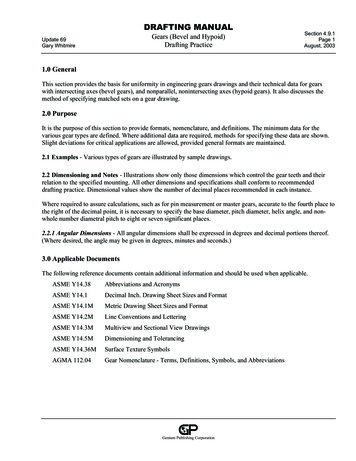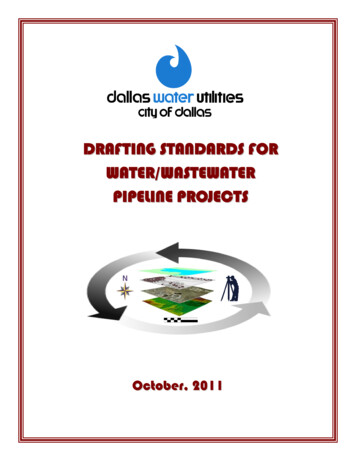
Transcription
CONTRACT DRAFTING ANDREVIEW MANUALOFFICE OF ATTORNEY GENERALAttorney General Wayne StenehjemThis edition supersedes all previously published editions of this manual.2018 EditionLast updated: JANUARY 2018Prepared by:The State and Local Government DivisionOffice of Attorney General
INTRODUCTIONThe contract manual is a guide for drafting and reviewing contracts entered into by anagency of the State of North Dakota.It has been written so that a preliminary draft of a proposed contract could be preparedby a non-attorney for review by the agency’s assigned legal counsel, either an assistantattorney general or special assistant attorney general.Although contracts are the product of policy decisions by the agency, it is recommendedthe Attorney General determine the legality of all contracts and offer suggestions andrecommendations on contract terms and language before a proposed contract isforwarded to the other party.Each agency should contact its assigned legal counsel for legalreview prior to executing any contract.This is particularly important if a contract contains unique or novel issues, imposes asignificant financial obligation on the state, or relates to a project that could createsignificant liability for the state.The contract language provided in this manual is a basis for state contracts. Eachcontract to which an agency may enter is unique and may contain unique terms andconditions. Specifically, technology contracts, contracts for public improvements andleases will be more complex than the foundation language provided in this manual.Agencies should always seek review and input from their assigned legal counsel.THE ANALYSIS IN THIS MANUALSUMMARIZES CURRENT LAW.THIS MANUAL IS NOT ANATTORNEY GENERAL’S OPINION.
TABLE OF CONTENTSCHAPTER 1 - OVERVIEW OF CONTRACT PROCESS . 1PURPOSE OF CONTRACT REVIEW . 1ROLE OF THE AGENCY . 1ROLE OF THE ATTORNEY GENERAL . 2CHAPTER 2 - TYPES OF STATE CONTRACTS . 3CONTRACTS FOR SERVICES . 3CONTRACTS FOR GOODS . 3INFORMATION TECHNOLOGY CONTRACTS . 3STATE TERM CONTRACTS AND COOPERATIVE PURCHASING CONTRACTS. 4CONTRACTS FOR PUBLIC IMPROVEMENTS (CONSTRUCTION CONTRACTS) . 4LEASES OF BUILDINGS OR REAL PROPERTY . 6INTERAGENCY LEASES . 6LEASES OF EQUIPMENT . 6INTERAGENCY AGREEMENTS . 7JOINT POWERS AGREEMENTS . 7AGREEMENTS WITH INDIAN TRIBES . 7CHAPTER 3 - PROCUREMENT AND PUBLIC IMPROVEMENTS. 9GOODS AND SERVICES . 9BIDS . 9PROPOSALS . 9REQUESTS FOR PROPOSALS AND INVITATIONS FOR BID . 9ARCHITECT, ENGINEER, AND LAND SURVEYING SERVICES . 10CHAPTER 4 - CONTRACT FORMATION AND INTERPRETATION . 11ESSENTIAL ELEMENTS OF A CONTRACT . 11CONTRACT INTERPRETATION . 12PUBLIC CONTRACTS . 12FORM OF CONTRACT . 12LANGUAGE . 13CHAPTER 5 - CONTRACT CLAUSES . 15PARTIES - IDENTIFYING THE PARTIES AND P URPOSE . 15SCOPE OF W ORK . 15COMPENSATION – PAYMENTS . 16TERM OF CONTRACT . 19TIME IS OF THE ESSENCE . 22TERMINATION . 23DELAY OR DEFAULT FORCE MAJEURE (NATURAL DISASTER/ACTS OF G OD) . 25LIQUIDATED DAMAGES . 25LIMITATIONS OF LIABILITIES. 26INDEMNIFICATION . 27INSURANCE . 28W ORKS FOR HIRE AND W ORK PRODUCT . 29NOTICE . 30i
CONFIDENTIALITY . 31COMPLIANCE WITH PUBLIC RECORDS LAWS . 31INDEPENDENT ENTITY . 32ASSIGNMENT AND SUBCONTRACTS . 33SPOLIATION (DESTRUCTION OR SEVERE MODIFICATION OF EVIDENCE ) . 34MERGER AND MODIFICATION – CONFLICT IN DOCUMENTS . 35SEVERABILITY . 36APPLICABLE LAW AND VENUE . 36ALTERNATIVE DISPUTE RESOLUTION – JURY TRIAL . 37ATTORNEY FEES AND COSTS . 38NONDISCRIMINATION – COMPLIANCE WITH LAWS . 38STATE AUDIT . 39EFFECTIVE DATE OF AGREEMENT . 40SIGNATURES . 40CHAPTER 6 – LEASE CLAUSES . 42PARTIES - IDENTIFYING THE PARTIES AND P URPOSE . 42SCOPE OF LEASE . 42TERM OF LEASE . 43HOLDING OVER . 43RENTAL PAYMENTS . 44LANDLORD’S OBLIGATIONS . 44STATE’S OBLIGATIONS . 46TERMINATION OF LEASE . 46MERGER AND MODIFICATION . 47SEVERABILITY . 48ASSIGNMENT – SALE OF PREMISES . 48NOTICE . 49APPLICABLE LAW AND VENUE . 49ALTERNATIVE DISPUTE RESOLUTION – JURY TRIAL . 50SPOLIATION (DESTRUCTION OR SEVERE MODIFICATION OF EVIDENCE ) . 51INDEMNIFICATION . 52INSURANCE . 52CONFIDENTIALITY . 53COMPLIANCE WITH PUBLIC RECORDS LAWS . 55STATE AUDIT . 55EFFECTIVE DATE OF LEASE . 56APPROVAL . 56SIGNATURES . 56APPENDICES . 1CONTRACT CHECKLIST . 2TEMPLATE, CONTRACT . 4CONSTRUCTION CONTRACT CHECKLIST . 14LEASE CHECKLIST – AGENCY AS TENANT . 17TEMPLATE, LEASE (AGENCY AS TENANT) . 19LEASE CHECKLIST – AGENCY AS LANDLORD . 26ii
TEMPLATE, LEASE (AGENCY AS LANDLORD) . 27LEASE CHECKLIST – INTERAGENCY LEASE . 33TEMPLATE, LEASE (INTERAGENCY). 34INTERAGENCY AGREEMENT CHECKLIST. 40JOINT POWERS AGREEMENT CHECKLIST . 48iii
CHAPTER 1 - OVERVIEW OF CONTRACT PROCESSPURPOSE OF CONTRACT REVIEWThe main purpose of contract review is to ensure that the expectations of the partiesare accurately described in a written contract. A well written contract avoidsunexpected liabilities and promotes a smooth relationship between the parties.Contracts should be reviewed by the agency’s assigned legal counsel to ensure thatthe agency complies with all applicable laws and is not committing itself to spendingmoney beyond the amount appropriated by the Legislature. This review isparticularly important for contracts that were not drafted by the agency (e.g., a“boilerplate” or “form” contract provided by a vendor).State agencies and officials have only those powers expressly provided by lawor which may necessarily be implied from the powers expressly given to theofficial or agency. 1 Every review of a contract must include a determinationwhether the agency is authorized to enter into the proposed contract.Since the state is not immune from liability for its actions, all state contracts shouldindicate how risks arising out of the contract are assigned among the parties to thecontract and what insurance coverage is required.All of the contract provisions included in this manual are important. Anagency should be reluctant to consider alternative language, removal oflanguage, or additional language proposed by a vendor or contractor.Changes to the provisions of this manual should only be made inconsultation with an agency’s assigned legal counsel.ROLE OF THE AGENCYOnce an agency determines that goods or services are needed from a specificcontractor, 2 or that another reason exists to enter into a contract, the agency mustdevelop a written agreement identifying the terms and conditions of the relationshipbetween the agency and the contractor.The most important responsibilities of an agency in establishing these terms andconditions are to:1State administrative agencies are creatures of legislative action and, as such, have only such authorityor power as is granted to them or necessarily implied from the grant. First Bank of Buffalo v. Conrad, 350N.W.2d 580, 584-85 (N.D. 1984).2See N.D.C.C. ch. 54-44.4 and N.D.A.C. art. 4-12 regarding bidding requirements for goods andservices.1
1.2.3.4.describe the goods or services the agency is purchasing or providing;state the dollar amount the agency will pay;determine how any risks of liability will be assigned among the parties tothe contract; andstate how the parties will comply with all applicable laws.In determining how much the agency will pay, the agency should keep in mind thatits ability to extend financial obligations beyond the current biennium is restricted.See N.D.C.C. §§ 54-16-03, 54-16-05, 54-44.1-10.ROLE OF THE ATTORNEY GENERALAll state officers must look to the Attorney General for opinions on legal questionsrelating to their official duties. N.D.C.C. § 54-12-01(6). The Attorney General is alsorequired to prepare drafts of state contracts when necessary. N.D.C.C.§ 54-12-01(7).Although contracts are the product of policy and business decisions by theagency, it is appropriate for the Attorney General to determine the legality ofall contracts.Legal review by the agency’s assigned legal counsel should occurbefore a proposed contract is forwarded to the other party.2
CHAPTER 2 - TYPES OF STATE CONTRACTSCONTRACTS FOR SERVICESThe service contract must not make the contractor an "employee" of the state. SeeIndependent Entity. Note also that an agency may be required to obtain services ona competitive basis. See N.D.C.C. ch. 54-44.4; N.D.A.C. art. 4-12 and the Office ofManagement and Budget (OMB) State Procurement Office (SPO) rement of architect, engineer, and land surveying services is governed byN.D.C.C. ch. 54-44.7.The standard contract checklist and contract template are Appendix 1-a andAppendix 1-b to this manual.CONTRACTS FOR GOODSMost materials, furniture, fixtures, printing, insurance, and other commodities usedby state agencies are purchased through OMB if the price of the goods exceeds acertain threshold. See generally N.D.C.C. ch. 54-44.4. An agency may be requiredto obtain goods on a competitive basis. See N.D.C.C. ch. 54-44.4; N.D.A.C. art. nd.gov/omb/agency/procurement.The standard contract checklist and contract template are Appendix 1-a andAppendix 1-b to this manual.INFORMATION TECHNOLOGY CONTRACTSInformation technology (IT) contracts require numerous terms and conditions thatare not applicable to contracts for services or contracts for goods. Because of theuniqueness of these terms and conditions they are not specifically covered in thismanual. These contracts should be reviewed with an agency’s assigned legalcounsel, the OMB State Procurement Office and the state’s Information TechnologyDepartment (ITD) for sufficiency.It is not uncommon for technology vendors to use automated end-user agreements(e.g. click-through, shrink-wrap or browse-wrap) that require end-users click in“agreement” to the terms prior to installing or using software or hardware. Theseautomated end-user agreements often contain terms and conditions to which a stateagency cannot agree. Furthermore, end-users likely do not have authority to agreeor contract on behalf of the agency. These agreements should be reviewed by theagency’s assigned legal counsel prior to acceptance. Most often, these automated3
end-user agreements are superseded by a master contract or a state term contract;however, there are times when language must be included in purchase orders tospecifically void the automated end-user agreement’s terms and conditions thatconflict with state law.Major IT projects, or “Large IT” projects, require the appointment of an executivesteering committee in accordance with N.D.C.C. § 54-59-32. It is imperative thatagencies procuring these IT goods or services consult assigned legal counsel fordetermination as to the applicability of N.D.C.C. § 54-59-32.Certain ITPurchasingInformationis found at:contracts for goods and services are negotiated as CooperativeContracts and are managed by the OMB State Procurement Office.specific to these Cooperative Purchasing Contracts and IT nt/it-procurement.STATE TERM CONTRACTS AND COOPERATIVE PURCHASING CONTRACTSThe OMB State Procurement Office maintains certain “State Term Contracts” underits Cooperative Purchasing authority in accordance with N.D.C.C. § 54-44.4-13. Thisauthority provides for the OMB State Procurement Office to enter into agreementson behalf of multiple state agencies (and other specified entities) when similar goodsor services are being procured by those agencies.Cooperative Purchasing Contracts require OMB to be a party to the contract. Thesecontracts should contain specific language from OMB informing the parties to thecontract and potential participating entities of the contract that it is a CooperativePurchasing agreement. OMB Procurement Office will provide this language forinclusion when required.A list of active State Term contracts is found -contracts.CONTRACTS FOR PUBLIC IMPROVEMENTS (CONSTRUCTION CONTRACTS)Because of the complexity involved in public improvement contracting, the industrystandard of using contracts drafted by the American Institute of Architects (AIA ) orthe Engineers Joint Contract Documents Committee (EJCDC ) should beacceptable to the agency. However, these contracts are drafted in favor of architectsand engineers and contain terms and conditions to which a state agency is withoutauthority to agree.Agencies should ensure that AIA contracts being used are the most current versionof that document. For example: AIA B105 -2017 should not be used rather thanan AIA B105 -2007. AIA contracts often reference additional AIA documents4
as being incorporated into the contract. It is imperative that the agency review ALLdocuments prior to executing the AIA contract and State’s Addendum.It is imperative that these standard contracts be reviewed andsupplemented with a State Addendum that is prepared by theagency’s assigned legal counsel or the Office of Attorney General.The contracting process for public improvement projects is subject to numerousrequirements in N.D.C.C. ch. 48-01.2. All bids and proposals for public improvementcontracts must include a copy of the license or certificate of renewal thereof issued bythe Secretary of State enclosed in the required bid bond envelope showing thecontractor is licensed as provided in N.D.C.C. ch. 43-07. N.D.C.C. § 43-07-12.Contractors with the state also must file a certificate showing the contractor has paidall applicable state taxes. N.D.C.C. § 43-07-11.1.A bidder's bond and a contractor's or performance bond are required for many publicimprovement and construction projects. N.D.C.C. ch. 48-01.2, N.D.C.C.§§ 48-01.2-05, 48-01.2-10. A bidder's bond generally must guarantee execution ofboth a contract and a contractor's or performance bond within ten (10) days afterreceiving notice that the contract has been awarded. A contractor's or performancebond must guarantee the contractor's performance of the contract and payment of allbills arising during the performance of the contract. A contractor's or performancebond must include requirements that:1.2.all bills or claims for labor or material be paid, including interest underN.D.C.C. § 13-01-14, for bills which are not paid within 90 days; andthe contractor will file a payroll report with workforce safety and insuranceand pay all required premiums. N.D.C.C. § 65-04-10.All construction contracts, except those involving federal aid or where a preferencewould be contrary to law, must include a clause requiring the contractor to givepreference to North Dakota residents in hiring, with preference given first toveterans. N.D.C.C. § 43-07-20.With some exceptions, any retention of amounts (i.e. retainage) due a contractorunder a public improvement contract is subject to 10% of each estimate presenteduntil the project is 50% complete, at which time retainage is based on thecontractor’s performance. N.D.C.C. §§ 43-07-23, 48-01.2-13.The public improvement (construction) contract checklist is Appendix 2 to thismanual.5
LEASES OF BUILDINGS OR REAL PROPERTYAll leases and rental agreements for office space, regardless if the role of the stateagency is as Landlord or Tenant, must be reviewed for legal sufficiency by theAttorney General and approved by the OMB. N.D.C.C. § 54-21-24.1.OMB’s procedure for completing a state office lease may be found ice-space.The standard lease checklist and lease template, wherein the state agency is thetenant, are Appendix 3-a-1 and Appendix 3-a-2 to this manual.The standard lease checklist and lease template, wherein the state agency is thelandlord, are Appendix 3-b-1 and Appendix 3-b-2 to this manual.INTERAGENCY LEASESInteragency leases are those executed between two or more state agencies.Because state agencies, by their very existence as such, are subject to a number ofstatutory requirements it is unnecessary to include all standard lease terms andconditions that would be included in a lease between a state agency and an outsidetenant or landlord.The interagency lease checklist and lease template are Appendix 3-c-1 andAppendix 3-c-2 to this manual.LEASES OF EQUIPMENTLeases of equipment can be converted to rental purchase agreements with theapproval of OMB, as long as the conversion is to the financial advantage of the stateand the agreement does not commit the state to payments beyond the currentbiennium. N.D.C.C. § 54-06-17. OMB has created a form to assist with thisdetermination, found -vspurchase-analysis.6
INTERAGENCY AGREEMENTSInteragency agreements, often referred to as a Memorandum of Agreement orMemorandum of Understanding, are those executed between two or more stateagencies. Because state agencies, by their very existence as such, are subject to anumber of statutory requirements it is unnecessary to include all standard contractterms and conditions that would be included in a contract between a state agencyand an outside vendor or entity.The interagency agreement checklist and agreement template are Appendix 4-a andAppendix 4-b to this manual.JOINT POWERS AGREEMENTSJoint powers agreements are a special category of contracts in which a state agencyenters into a binding agreement with another state agency or with a politicalsubdivision of the state of North Dakota. N.D.C.C. chs. 54-40 and 54-40.3 authorizestate agencies and political subdivisions to enter into joint powers agreements whenother, specific statutory authority may not exist.Joint powers agreements may be used for a number of purposes, including:acquiring, constructing, and maintaining any building for the joint use of thecontracting government agencies; the use of buildings under the control of the state;and the joint exercise of any power or function that any of the parties to theagreement is authorized to perform. See generally N.D.C.C. chs. 54-40, 54-40.3.N.D.C.C. § 54-40.3-01 is very broad; it authorizes political subdivisions and stateagencies to enter into joint powers agreements to cooperate or jointly administer anypower or function that only one of the parties to the agreement is obligated. Jointpowers agreements do not relieve the agency of its statutory duties, but actual andtimely performance of those duties by another party created by the joint powersagreement is sufficient. N.D.C.C. § 54-40.3-01(3) and N.D.A.G. 94-F-08.Joint powers agreements authorized under N.D.C.C. ch. 54-40 must contain certainprovisions. Joint powers agreements authorized under N.D.C.C. ch. 54-40.3 have norequired form, but a number of suggested contract topics are listed in N.D.C.C.§ 54-40.3-01(1). The Attorney General must determine that joint powers agreementsthat involve state agencies are legally sufficient. See N.D.C.C. §§ 54-40-08,54-40.3-01(2), and 54-40.3-04.The joint powers agreement checklist is Appendix 5 to this manual.AGREEMENTS WITH INDIAN TRIBES7
Some agreements between a public agency and an Indian tribe are governed byN.D.C.C. ch. 54-40.2. If N.D.C.C. ch. 54-40.2 applies, the state agency involvedmust publish notice of the agreement and, if requested, hold a public hearing. Theseagreements must be approved by the Governor and by the governing body of thetribes involved. N.D.C.C. § 54-40.2-04. In addition, agreements with an Indian tribemay implicate federal statutes and regulations. The Natural Resources and IndianAffairs Division of the Attorney General’s office has an assistant attorney generalwho is available for consultation on these agreements.8
CHAPTER 3 - PROCUREMENT AND PUBLIC IMPROVEMENTSGOODS AND SERVICESGoods and services purchased by OMB State Procurement Office on behalf of stateagencies under N.D.C.C. ch. 54-44.4, or pursuant to purchasing authority delegatedby OMB, are usually purchased under a competitive procurement procedure. TheOMB State Procurement Office develops specifications, receives bids, and mayreject any bids or negotiate for a lower price with the successful bidder. Termcontracts and multiple awards for certain contracts are also authorized underN.D.C.C. § 54-44.4-05. For more information regarding the bidding process, see nd.gov/omb/agency/procurement.BIDSFor certain contracts, competitive bids are required. Examples of these contractsinclude:1.2.3.4.5.Contracts for construction of public improvements if the estimated costexceeds 150,000. N.D.C.C. § 48-01.2-02.1.Concessions in public buildings or on public grounds. N.D.C.C.§ 48-09-01.Highway construction contracts exceeding 20,000. N.D.C.C. § 24-02-17.State printing contracts. N.D.C.C. ch. 46-02.State purchasing contracts. N.D.C.C. § 54-44.4-05.An agency subject to bidding requirements should be very careful to review andfollow all requirements set out in law and administrative rule.PROPOSALSA request for proposals (RFP) is similar to the bid process but gives the agencyadditional flexibility after receiving proposals from potential contractors. Frequently,the process includes competitive negotiation with the bidders based on acomparison of the proposals received by the agency.REQUESTS FOR PROPOSALS AND INVITATIONS FOR BIDWhen preparing an RFP or Invitation for Bid (IFB), the agency should specify boththe terms and conditions it will require in the contract and those that areunacceptable. This gives potential contractors notice of the state's contractingrequirements. Solicitation templates are available at the OMB State ProcurementOffice website at:9
https://www.nd.gov/omb/agency/procurement.Some RFP’s, specifically IT-related, contain provisions requiring the potentialcontractor to affirmatively agree, disagree or propose new language for eachcontract clause contained in the state’s contract template specific to that solicitation.Proposals that fail to respond to these provisions may be deemed non-responsiveand be rejected by the procuring agency. The intent of requiring responses specificto the contract language is to be up front about negotiation positions and to ensureall parties are negotiating contract terms in good faith.ARCHITECT, ENGINEER, AND L AND SURVEYING SERVICESThe procurement of architect, engineer, and land surveying services is governed byN.D.C.C. ch. 54-44.7. Standard engineering and architectural contracts drafted bythe Engineers Joint Contract Documents Committee (EJCDC ) and AmericanInstitute of Architects (AIA ) favor engineers and architects and contain terms towhich a state agency may not agree.It is imperative that these standard contracts be reviewed andsupplemented wit
The contract manual is a guide for drafting and reviewing contracts into by an entered agency of the State of North Dakota. It has been written so that a preliminary draft of a proposed contract could be prepared by a non-attorney for review by the agency’s assigned legal counsel, either an File Size: 1MBPage Count: 115
